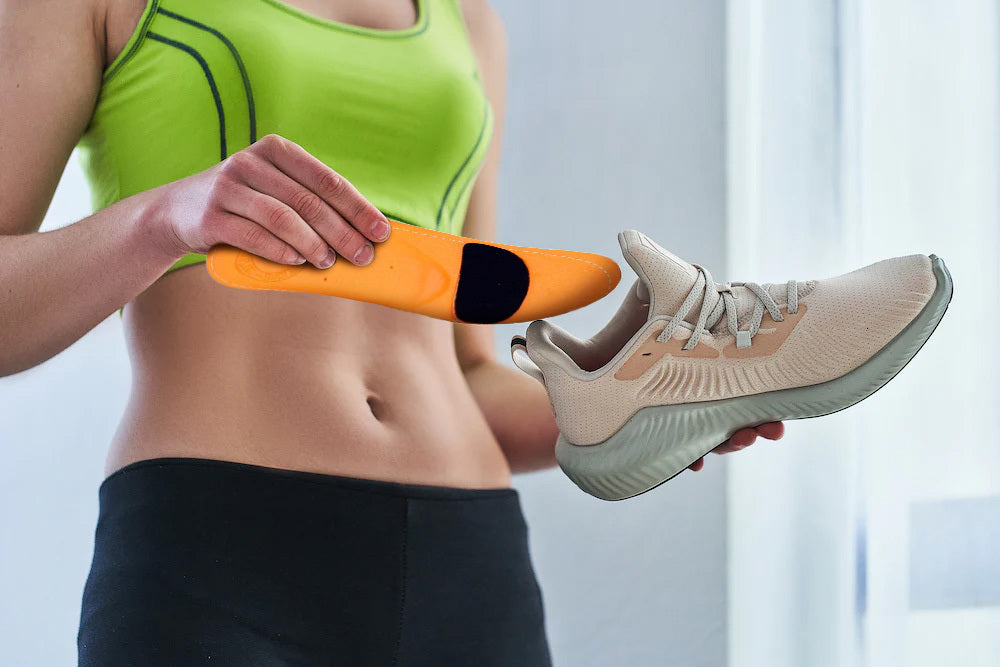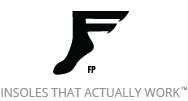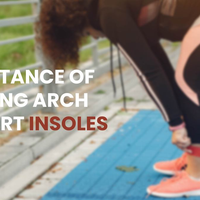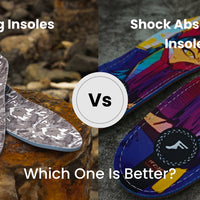How Do You Know if You Need Arch Support? Look for These 6 Signs

In the hustle and bustle of our daily lives, our feet silently bear the load of every step we take. Within the intricate framework of bones, muscles and tendons, the arches of our feet play a significant role. Your arches help distribute your body weight, absorb shocks and aid movement. Ignoring its care can lead to discomfort and foot issues. But how do you know if you need arch support?
By understanding the importance of arch support and recognizing the signs your feet might be sending you, you can take proactive steps toward enhancing your overall comfort and well-being.
Understanding Your Foot Arch
It’s important to understand each type of foot arch and how it can affect your foot health. Your arch supports your body while walking and running, aiding balance, particularly on diverse terrains. While feet are suited for cushioned surfaces, hard floors can lead to discomfort. Shoes without the proper arch support may need to be compensated with orthotics.
The height and structure of your arch determine how your foot functions and distributes weight. Figuring out your arch type is the first step toward having better foot health. Let's look at the three main arch types:
High Arches
With a high arch, there is a visible curve along the inner side of your foot. A high arch shifts pressure to the balls and heels of your feet. While it might seem like a natural advantage, this arch type can lead to discomfort and challenges in shock absorption. The resulting strain can trigger muscle pain, joint tension and conditions like plantar fasciitis or metatarsalgia.
Medium Arch
With a medium arch, part of your arch will be slightly raised off the ground when standing. You should be able to slip a thin piece of paper under the curved inner band of your foot. This is the most common type and is well-balanced, flattening to support body weight and absorb shock as you walk.
Low/Flat Arch
With a low or flat arch, your entire footprint contacts the ground. Flat or low arches lack the arch structure to support your feet properly. This can lead to overpronation as your foot rolls inward too much. Flat feet can cause poor stability, alignment issues and pain without enough arch support.

How Do You Know if You Need Arch Support?
Finding the proper footwear is crucial for comfort and avoiding injuries, especially if you're often on your feet. Arch support, in particular, can make a big difference in how your feet feel at the end of the day. Do you need arch support to improve your foot health and comfort? Here are signs to look out for:
1. Foot Pain or Discomfort
One of the clearest indicators that you may need more arch support is persistent or worsening foot pain, especially in the arch or heel areas. This pain may feel like stabbing sensations, numbness or aching, particularly after long periods of standing or activity. Common culprits include plantar fasciitis or inadequate support for flat feet or high arches.
2. Changes in Your Shoes
Take a peek at the edges of your shoes — do you notice more wear on the inside or outside edges? This lopsided wearing can signify your feet are rolling inward or outward excessively as you walk. Respectively known as overpronation and supination (or underpronation), this uneven pressure can lead to foot problems down the road.
3. Swollen Feet or Ankles
Swelling or inflammation in the feet and ankles can arise from arch issues like flat feet or high arches. Fluid can accumulate when the muscles and ligaments overcompensate for lack of support during activity.
4. Lower Body Pain
Since your feet are the foundation for your whole body, insufficient arch support can contribute to aches and pains elsewhere, like the knees, hips and/or lower back.
5. Active Lifestyle
Athletes or people whose jobs require hours of standing or walking should pay close attention to arch support needs. Intense impact on the feet increases your risk of overuse injuries and plantar fasciitis, especially if your arches are unsupported.
6. Frequent Ankle Sprains
Recurrent ankle rolling and sprains may indicate you need better arch support. Insufficient arch support allows the ankle to roll inward or outward too easily, straining the ligaments and eventually causing instability.
Benefits of Using Arch Supports
Arch supports offer great benefits for your foot health and enhanced comfort when correctly fitted and used. Here are six reasons to give arch supports a try:
- Improved Foot and Leg Comfort: One of the direct effects of using arch supports is enhanced comfort in your feet, ankles and legs. Arch supports can relieve aches and pains by providing cushioning and support where you need it most.
- Enhanced Athletic Performance: Arch supports can improve alignment and stability for runners and athletes. This helps you move more efficiently and absorb shock, potentially boosting your endurance and preventing injury.
- Prevention of Foot-Related Complications: Supporting your arches can alleviate excessive pressure on parts of the feet that are vulnerable to problems like plantar fasciitis. Arch supports may also slow the progression of issues like fallen arches.
- Better Posture and Alignment: Arch supports help redistribute weight and improve gait mechanics, ultimately optimizing your overall body alignment. This takes the pressure off your knees, hips and back.
- Reduce Pain: Many common foot ailments like metatarsalgia, heel spurs and bunions cause painful symptoms. Arch supports can be a helpful first step in treatment, providing relief without needing to consider more invasive options.
- Improve Stability and Balance: Filling your arch gaps provides a more stable base for your feet and improves balance. This enhances coordination and helps prevent falls.

Risks of Ignoring Arch Problems
If you need arch support, leaving these issues unaddressed can lead to more severe consequences. Mild discomfort may initially seem harmless, but the problems can worsen. Here are some of the potential risks associated with not properly supporting your arches:
- Development of Foot Conditions: One of the most common is plantar fasciitis, which causes stabbing heel pain. Flat feet or fallen arches are also more prone to developing plantar fasciitis when left without arch reinforcement over time.
- Aggravation of Existing Issues: If you already have foot problems like bunions or arthritis, lack of arch support could worsen these symptoms.
- Potential for Joint Pain: Arch problems like flat feet or high arches can cause poor alignment and misalignment in the legs and feet. This misalignment then places excess strain on the knees, hips, and lower back without arch supports. Long-term strain can later result in chronic pain in those areas.
- Increased Injury Risk: Unstable or poorly aligned feet increase your chances of sprains and fractures, especially for athletes. Proper arch support provides shock absorption and weight distribution to prevent injury.
- Balance and Stability Problems: Weak arches affect the steadiness of your foundation, leading to poor balance, falls and reduced coordination. Utilizing arch supports can effectively enhance your stability.
How Does Pregnancy Affect Foot Arch?
Pregnancy hormones like relaxin and progesterone loosen ligaments to prepare for childbirth. However, these hormones circulate everywhere, relaxing your foot ligaments too. Additionally, extra pregnancy weight typically flattens arches further. This combination often leads to overpronated, strained feet. Arch-supporting orthotics can help maintain proper alignment and support throughout pregnancy.
Do Children Need Arch Support?
Keeping a close eye on your child’s developing feet is crucial in preventing long-term problems. Arch supports can benefit kids as young as one but are especially important when gait forms between the ages of two and three. If not addressed, foot issues that arise as children grow can interfere with alignment and movement in the long-term.
Proper arch support in the early years, especially for active kids playing sports, helps avoid overuse injuries. Catching foot issues early and getting custom orthotics can set your child on a good trajectory for lifelong foot health.
Seeking Professional Help
Figuring out what right arch support you need can be confusing with so many choices on the market. The best way to know what you need is to consult a podiatrist and get an expert assessment. They'll check out your feet, analyze how you walk, diagnose conditions and suggest the proper support for your unique needs.
Comfort insoles, also called flat insoles, offer basic cushioning to make shoes cozier. They provide versatile cushioning and shock absorption for anyone seeking extra comfort. Arch support insoles, including orthotics or custom orthotics, provide targeted relief and realignment for specific foot issues like overpronation or plantar fasciitis. They support the foot's natural arch and help rebalance the feet.
With a professional's guidance, you can skip the guesswork and get the best fit without wasting money on trial and error. For tips on how to find the right insoles for you, check out our handy Buying Guide.
Get Customized Arch Support with FP Insoles
Supporting your arches keeps your body aligned and balanced by allowing proper weight distribution and shock absorption. Listen to the signs your feet give you and ensure you get the arch support you need.
At FP Insoles, we offer game-changing, shock-absorbing products that provide customized arch support to relieve everyday pain. Our NASA-approved insoles aim to be inclusive of all arch types.
Providing your arches with quality care will prevent lasting issues and keep you moving comfortably. Browse our collection of insoles designed to contour perfectly to your feet.





